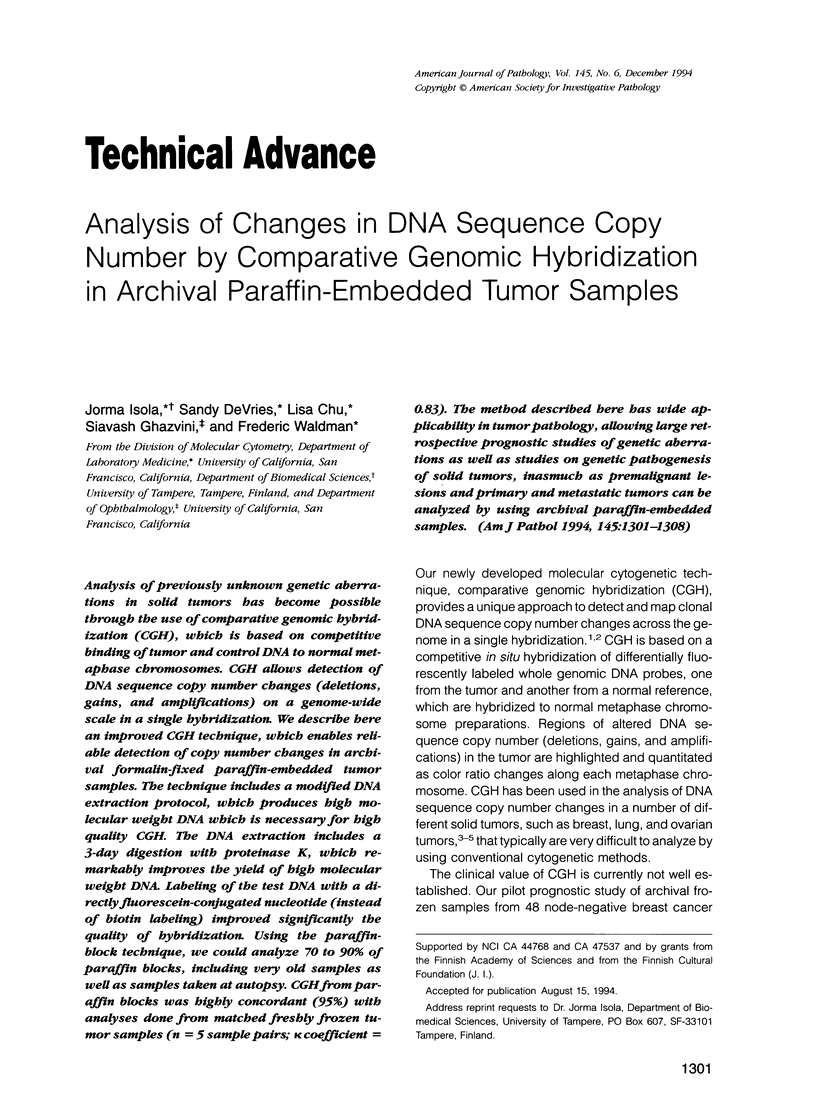Analysis of changes in DNA sequence copy number by comparative genomic hybridization in archival paraffin-embedded tumor samples (original) (raw)
. 1994 Dec;145(6):1301–1308.
Abstract
Analysis of previously unknown genetic aberrations in solid tumors has become possible through the use of comparative genomic hybridization (CGH), which is based on competitive binding of tumor and control DNA to normal metaphase chromosomes. CGH allows detection of DNA sequence copy number changes (deletions, gains, and amplifications) on a genome-wide scale in a single hybridization. We describe here an improved CGH technique, which enables reliable detection of copy number changes in archival formalin-fixed paraffin-embedded tumor samples. The technique includes a modified DNA extraction protocol, which produces high molecular weight DNA which is necessary for high quality CGH. The DNA extraction includes a 3-day digestion with proteinase K, which remarkably improves the yield of high molecular weight DNA. Labeling of the test DNA with a directly fluorescein-conjugated nucleotide (instead of biotin labeling) improved significantly the quality of hybridization. Using the paraffin-block technique, we could analyze 70 to 90% of paraffin blocks, including very old samples as well as samples taken at autopsy. CGH from paraffin blocks was highly concordant (95%) with analyses done from matched freshly frozen tumor samples (n = 5 sample pairs; kappa coefficient = 0.83). The method described here has wide applicability in tumor pathology, allowing large retrospective prognostic studies of genetic aberrations as well as studies on genetic pathogenesis of solid tumors, inasmuch as premalignant lesions and primary and metastatic tumors can be analyzed by using archival paraffin-embedded samples.

Images in this article
Selected References
These references are in PubMed. This may not be the complete list of references from this article.
- Dubeau L., Chandler L. A., Gralow J. R., Nichols P. W., Jones P. A. Southern blot analysis of DNA extracted from formalin-fixed pathology specimens. Cancer Res. 1986 Jun;46(6):2964–2969. [PubMed] [Google Scholar]
- Goelz S. E., Hamilton S. R., Vogelstein B. Purification of DNA from formaldehyde fixed and paraffin embedded human tissue. Biochem Biophys Res Commun. 1985 Jul 16;130(1):118–126. doi: 10.1016/0006-291x(85)90390-0. [DOI] [PubMed] [Google Scholar]
- Hedley D. W., Clark G. M., Cornelisse C. J., Killander D., Kute T., Merkel D. DNA Cytometry Consensus Conference. Consensus review of the clinical utility of DNA cytometry in carcinoma of the breast. Breast Cancer Res Treat. 1993 Oct;28(1):55–59. doi: 10.1007/BF00666357. [DOI] [PubMed] [Google Scholar]
- Hedley D. W., Friedlander M. L., Taylor I. W., Rugg C. A., Musgrove E. A. Method for analysis of cellular DNA content of paraffin-embedded pathological material using flow cytometry. J Histochem Cytochem. 1983 Nov;31(11):1333–1335. doi: 10.1177/31.11.6619538. [DOI] [PubMed] [Google Scholar]
- Hopman A. H., van Hooren E., van de Kaa C. A., Vooijs P. G., Ramaekers F. C. Detection of numerical chromosome aberrations using in situ hybridization in paraffin sections of routinely processed bladder cancers. Mod Pathol. 1991 Jul;4(4):503–513. [PubMed] [Google Scholar]
- Jackson D. P., Lewis F. A., Taylor G. R., Boylston A. W., Quirke P. Tissue extraction of DNA and RNA and analysis by the polymerase chain reaction. J Clin Pathol. 1990 Jun;43(6):499–504. doi: 10.1136/jcp.43.6.499. [DOI] [PMC free article] [PubMed] [Google Scholar]
- Joos S., Scherthan H., Speicher M. R., Schlegel J., Cremer T., Lichter P. Detection of amplified DNA sequences by reverse chromosome painting using genomic tumor DNA as probe. Hum Genet. 1993 Feb;90(6):584–589. doi: 10.1007/BF00202475. [DOI] [PubMed] [Google Scholar]
- Kallioniemi A., Kallioniemi O. P., Piper J., Tanner M., Stokke T., Chen L., Smith H. S., Pinkel D., Gray J. W., Waldman F. M. Detection and mapping of amplified DNA sequences in breast cancer by comparative genomic hybridization. Proc Natl Acad Sci U S A. 1994 Mar 15;91(6):2156–2160. doi: 10.1073/pnas.91.6.2156. [DOI] [PMC free article] [PubMed] [Google Scholar]
- Kallioniemi A., Kallioniemi O. P., Sudar D., Rutovitz D., Gray J. W., Waldman F., Pinkel D. Comparative genomic hybridization for molecular cytogenetic analysis of solid tumors. Science. 1992 Oct 30;258(5083):818–821. doi: 10.1126/science.1359641. [DOI] [PubMed] [Google Scholar]
- Kallioniemi O. P., Kallioniemi A., Piper J., Isola J., Waldman F. M., Gray J. W., Pinkel D. Optimizing comparative genomic hybridization for analysis of DNA sequence copy number changes in solid tumors. Genes Chromosomes Cancer. 1994 Aug;10(4):231–243. doi: 10.1002/gcc.2870100403. [DOI] [PubMed] [Google Scholar]
- Mies C., Houldsworth J., Chaganti R. S. Extraction of DNA from paraffin blocks for Southern blot analysis. Am J Surg Pathol. 1991 Feb;15(2):169–174. doi: 10.1097/00000478-199102000-00010. [DOI] [PubMed] [Google Scholar]
- Ried T., Petersen I., Holtgreve-Grez H., Speicher M. R., Schröck E., du Manoir S., Cremer T. Mapping of multiple DNA gains and losses in primary small cell lung carcinomas by comparative genomic hybridization. Cancer Res. 1994 Apr 1;54(7):1801–1806. [PubMed] [Google Scholar]
- Speicher M. R., du Manoir S., Schröck E., Holtgreve-Grez H., Schoell B., Lengauer C., Cremer T., Ried T. Molecular cytogenetic analysis of formalin-fixed, paraffin-embedded solid tumors by comparative genomic hybridization after universal DNA-amplification. Hum Mol Genet. 1993 Nov;2(11):1907–1914. doi: 10.1093/hmg/2.11.1907. [DOI] [PubMed] [Google Scholar]